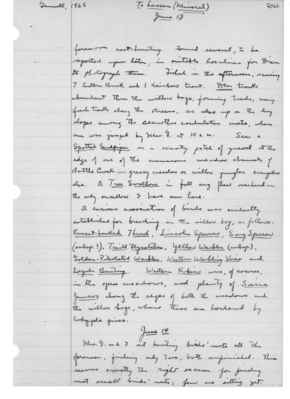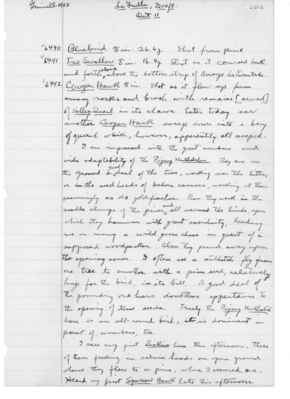Pages That Mention Tree Swallow
1925: Joseph Grinnell's field notes
S2 Page 6
Collector: Grinnell - 1925 Location: Lassen Section (Mineral) Date: June 13-14, 1925 Page Number: 2462
forenoon nest-hunting. Found several, to be reported upon later, in suitable locations for Dixon to photograph them. Fished in the afternoon, securing 7 Eastern Brook and 1 Rainbow Trout. Deer tracks abundant thru the willow bogs, forming trails; many fresh tracks along the streams, as also up on the dry slopes among the Ceanothus cordulatus mats, where one was jumped by Mrs. G at 10 a.m. Saw a Spotted Sandpiper on a scanty patch of gravel at the edge of one of the numerous meadow channels of Battle Creek - grassy meadows on willow jungles everywhere else. A Tree Swallow in full song flew overhead - the only swallow I have seen here. A curious association of birds was evidently established for birding in the willow bog, as follows: Russet-backed Thrush, Lincoln Sparrow, Song Sparrow (subsp.?), Traill Flycatcher, Yellow Warbler (subsp.), Golden-Pileolated Warbler, Western Warbling Vireo and Lazuli Bunting. Western Robins were, of course, in the open meadows, and plenty of Sierra Juncos along the edges of both the meadows and the willow bogs, where these are bordered by lodgepole pines. June 14 Mrs. G. and I out hunting birds' nests all the forenoon, finding only two, both unfinished. This seems exactly the right season for finding most small birds' nests; few are sitting yet.
S2 Page 63
Collector: Grinnell - 1925 Location: Mineral, 4800 ft. Date: July 2 Page Number: 2516
we came. The four young are saved in formalin: 6282 Hammond Flycatcher, 4 small young under this number.
Other birds seen on the big meadow this forenoon were: Vaux Swift (3 flew close over the tree-tops); Tree Swallow (twittering young in company of adults were flying about over the open part of the meadow); Western Bluebird (a family on fence and in meadow).
July 3 5 p.m. - With the family on Turner Mountain, the highest elevation immediately south of Battle Creek Meadows - altitude "6300 feet", according to Mr. J.M. Stark, in winter a school-teacher in Corning, for the three summer months Forest Service Lookout on this Mountain. From here, we get a grand view (after a thunderstorm - 43 lightning strikes counted by Mr. Stark - earlier this afternoon) of Brokeoff Mt. and Mt. Lassen, and the vast surrounding timbered mountain mass. On the north side of this mountain is a perfect glacial cirque (a residual snow bank under its rim now) with a series of hummocky moraines, and two lakes impounded. A few scrub red firs and two or three alpine hemlocks and mountain pines straggle around the uppermost rim; below, around the lakes, are close stands of hemlock and lodgepole pines, the timber elsewhere above about the 5500 contour being red-fir. But the greater portion of the area in the vicinity of the top, is covered densely with chaparral. Right here on top this chaparral is wind-beaten but dense, and
S3 Page 39
Collector: Grinnell - 1925 Location: La Grulla, 7200 ft. Date: Oct. 11 Page Number: 2582 6490 Bluebird (male sign) im. 26.6g. Shot from pine. 6491 Tree Swallow (male sign) im. 16.4g. Shot as it coursed back and forth alone above the bottom strip of Arroyo La Encantada. 6492 Cooper Hawk. (male sign) im. Shot as it flew up from among rocks and brush with remains [saved] of Valley Quail in its claws. Later today saw another Cooper Hawk sweep down into a bevy of quail which, however, apparently all escaped. I am impressed with the great numbers and wide adaptability of the Pigmy Nuthatches. They are on the ground a good deal of the time, working over the litter; or in the seed heads of Salvia carnosa, working at them seemingly as do goldfinches. Then they work in the needle clumps of the pines, and all around the limbs upon which they hammer with great assiduity, leading me on many a wild goose chase in quest of a supposed woodpecker. Also they pound away upon the opening cones. I often see a nuthatch fly from one tree to another with a pine seed, relatively huge for the bird, in its bill. A good deal of the pounding one hears doubtless appertains to the opening of these seeds. Truly the Pigmy Nuthatch here is an all-round bird; it is dominant in point of numbers, too. I saw my first Siskins here this afternoon, three of them feeding in salvia heads on open ground whence they flew to a pine, where I secured one. Heard my first Sparrow Hawk late this afternoon.


